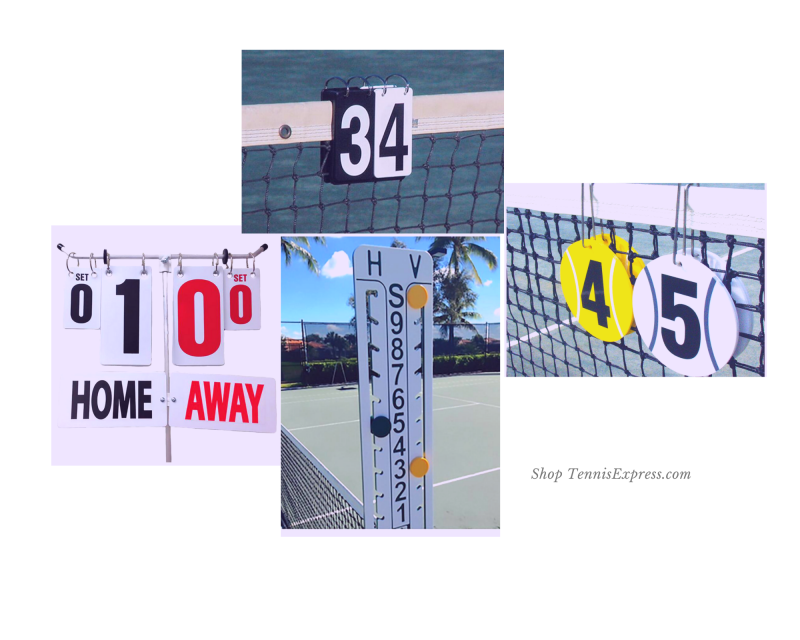Tennis scoring can be intense, emotional, and very complicated; similar to love. Especially when it comes to deciding points and tiebreakers. If you’re not careful, you could easily lose track of the score before you realize that you just played match-point.
Although the game uses romantic nicknames such as “love” in substitute for zero, and “deuce” to indicate a pivotal point, where the next two points can decide the game. There are several other unconventional tennis terms: words like advantage, ad-out, and breakpoint. Not to mention some tennis players have incorporated a few slang words into their tennis games.
Here is a basic outline to help players, at all levels, understand how to keep score and what tennis lingo they need to be aware of.
Basic Tennis Scoring Rules
Let’s talk through the basics of tennis scoring shall we? Think of a tennis match as being made up of three parts: Game, Set, and Match.
The average game consists of 4 or more points where each point has a nickname. The alias for zero points is “love.” The server begins the match by calling their score first, and then their opponent’s. At the beginning of a match, the server should announce, “Love all.” They will serve the first ball from the right side of their court to their opponent, standing on their right side of their court, which is also referred to as the “Deuce Side.” The server has two opportunities to make their serve into the service box, before losing a point and moving to the left side of the court, also known as the “Ad Side”. The server will rotate from the Deuce and Ad side of the court until all the points are played and the game is won. Remember, the match isn’t over, that’s only one game.

Here’s an example: if you were serving, and you were to get the first two points of the game, your score would be 30-love. If your opponent gets the next two points, in the same game, the score would be 30 all.
If a tie occurs at 40 all, it is referred to as deuce. A player must win two consecutive points in order to win that game. If the server wins the first deuce point, they would announce, “Ad-In.” If the server loses the first deuce point, they would say, “Ad-Out” (Ad is short for advantage).
If the server has the advantage but does not get the next point, the score reverts back to deuce, and the process begins again until one player achieves two consecutive points, and the game concludes.
Players switch sides after the first game, and then every two games until the set concludes. A good memory trick is to remember that you only switch sides of the court on the odd number of games in a set. If the set ends on an even number, you stay on your respective sides and then switch sides after the first game is played in the second or third set.
Tennis Scoring History
Where did all of this start and how was scoring really created? There are several legends about the origin of tennis and where its crazy scoring came from.
One theory speculates that during Medieval Times, a clock face was used to keep score during some of the first matches ever played. After a designated number of points were exchanged, the clock hand was moved a quarter turn to 15 minutes after the hour, in favor of the player who was ahead. Additional points were played, and again, the clock hand was rotated a quarter turn, indicating 30 minutes after the hour. The match would conclude after 60 minutes of play, and whoever was ahead, was declared the winner.
Of course, there are a few loopholes with this theory. The first being that mechanical clocks, especially portable ones, had not yet been invented.
Although this philosophy has been debunked, it’s still a cool story that reminds us “Time is of the Essence.” If you want to keep track of your time on the court, and maybe even monitor your fitness regimen, check out these nifty tools at Tennis Express.com.

Scorekeepers
There are a variety of scorekeepers to assist players in keeping track of how many games have already been played.
Games are accumulated to make a set score and the first player to win six games wins the set. In the event of a tiebreak, where each player has six games apiece, they would play a tiebreaker.
Tiebreaker Scoring
Tiebreakers come in all shapes and sizes.
Traditional 7-Point Tiebreaker (Called a “12 point tiebreaker” historically)
The traditional tiebreaker is played near the end of a set when the game score is 6-6. Immediately, players will engage in a 7-point tiebreak to decide who will win the set. There aren’t any fancy nicknames for the points. Here’s it’s just the standard one, two, three and so on.
Although you stay in service rotation, the next server will only serve one point, from the deuce side. Then their opponent will serve two points, beginning with the Ad Side. Players will switch court sides every six points until a set winner is decided. Keep in mind, a player must win a tiebreaker by two points.
Just as games make up a set, the sets make up a match. The most common method of scoring a match is best two out of three sets.
10 or 12 Point Tiebreaker (often referred to as Super Tie Break, or Match Tie Break)
These tiebreakers are more commonly used in lieu of a third set.
Essentially, they mirror the traditional 7-point tiebreaker, however, they require additional points to decide a champion. Again, the victor is required to win by two points, even in a match that has lasted for hours.
Tournaments, as well as leagues, have various scoring rules in place. It’s always best to speak with your opponent BEFORE a match begins and clarify any conditions or guidelines you are unclear on.
To learn more about scoring, check out the USTA rules.

Common Scoring Disputes
Scoring disputes come up in matches with players of all walks of life and of all skill levels. Let’s identify some of the conflicts and resolutions that can help eliminate some of these common scoring disputes.
Conflict: Players lose track of the score, especially after a long rally or several games.
Resolution: The best way to eliminate this issue is by making it a priority for each server to call out the score loudly before the point starts and make sure both parties are in agreement with the current score.
Conflict: One player calls the ball out, but the other believes it was in.
Resolution: Before starting, ensure that both players are aware that the player the side of the court where the ball lands has the primary responsibilty for making the call.
Conflict: Confusion over when to change ends, especially in tiebreak situations
Resolution: Clarify the rules before the match. (players should switch ends after every odd game)
Now that you have a better understanding of the scoring, how we believe it was created, and even different ways to eliminate scoring disputes, it’s time to hit the court and implement the things you have learned. Find all of the products and gear you need to help you look and play your best at www.TennisExpress.com.
To stay updated on the lastest news and best deals, subscribe to the blog!
For More:





